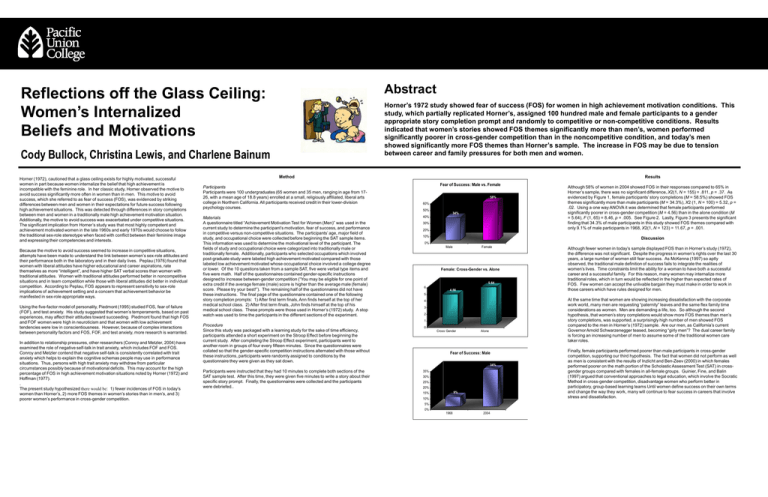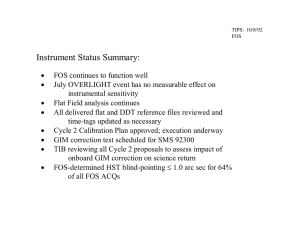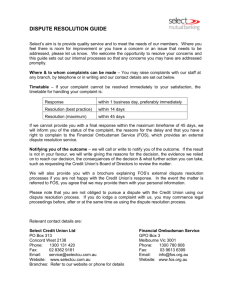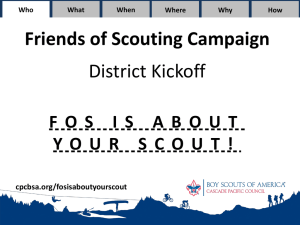Reflections off the Glass Ceiling: Abstract
advertisement

Abstract Reflections off the Glass Ceiling: Women’s Internalized Beliefs and Motivations Horner’s 1972 study showed fear of success (FOS) for women in high achievement motivation conditions. This study, which partially replicated Horner’s, assigned 100 hundred male and female participants to a gender appropriate story completion prompt and randomly to competitive or non-competitive conditions. Results indicated that women’s stories showed FOS themes significantly more than men’s, women performed significantly poorer in cross-gender competition than in the noncompetitive condition, and today’s men showed significantly more FOS themes than Horner’s sample. The increase in FOS may be due to tension between career and family pressures for both men and women. Cody Bullock, Christina Lewis, and Charlene Bainum Horner (1972), cautioned that a glass ceiling exists for highly motivated, successful women in part because women internalize the belief that high achievement is incompatible with the feminine role. In her classic study, Horner observed the motive to avoid success significantly more often in women than in men. This motive to avoid success, which she referred to as fear of success (FOS), was evidenced by striking differences between men and women in their expectations for future success following high achievement situations. This was detected through differences in story completions between men and women in a traditionally male high achievement motivation situation. Additionally, the motive to avoid success was exacerbated under competitive situations. The significant implication from Horner’s study was that most highly competent and achievement motivated women in the late 1960s and early 1970s would choose to follow the traditional sex-role stereotype when faced with conflict between their feminine image and expressing their competencies and interests. Because the motive to avoid success seemed to increase in competitive situations, attempts have been made to understand the link between women’s sex-role attitudes and their performance both in the laboratory and in their daily lives. Peplau (1976) found that women with liberal attitudes have higher educational and career aspirations, rate themselves as more “intelligent”, and have higher SAT verbal scores than women with traditional attitudes. Women with traditional attitudes performed better in noncompetitive situations and in team competition while those with liberal attitudes did better in individual competition. According to Peplau, FOS appears to represent sensitivity to sex-role implications of achievement setting and a concern that achievement behavior be manifested in sex-role appropriate ways. Using the five-factor model of personality, Piedmont (1995) studied FOS, fear of failure (FOF), and test anxiety. His study suggested that women’s temperaments, based on past experiences, may affect their attitudes toward succeeding. Piedmont found that high FOS and FOF women were high in neuroticism and that women with low achievement tendencies were low in conscientiousness. However, because of complex interactions between personality factors and FOS, FOF, and test anxiety, more research is warranted. In addition to relationship pressures, other researchers (Conroy and Metzler, 2004) have examined the role of negative self-talk in trait anxiety, which includes FOF and FOS. Conroy and Metzler contend that negative self-talk is consistently correlated with trait anxiety which helps to explain the cognitive schemas people may use in performance situations. Thus, persons with high trait anxiety may withdraw from particular circumstances possibly because of motivational deficits. This may account for the high percentage of FOS in high achievement motivation situations noted by Horner (1972) and Hoffman (1977). . The present study hypothesized there would be: 1) fewer incidences of FOS in today’s women than Horner’s, 2) more FOS themes in women’s stories than in men’s, and 3) poorer women’s performance in cross-gender competition. Method Participants Participants were 100 undergraduates (65 women and 35 men, ranging in age from 1726, with a mean age of 18.8 years) enrolled at a small, religiously affiliated, liberal arts college in Northern California. All participants received credit in their lower-division psychology courses. Materials A questionnaire titled “Achievement Motivation Test for Women (Men)” was used in the current study to determine the participant’s motivation, fear of success, and performance in competitive versus non-competitive situations. The participants’ age, major field of study, and occupational choice were collected before beginning the SAT sample items. This information was used to determine the motivational level of the participant. The fields of study and occupational choice were categorized into traditionally male or traditionally female. Additionally, participants who selected occupations which involved post-graduate study were labeled high achievement motivated compared with those labeled low achievement motivated whose occupational choice involved a college degree or lower. Of the 10 questions taken from a sample SAT, five were verbal type items and five were math. Half of the questionnaires contained gender-specific instructions designed to increase between-gender competition (“You may be eligible for one point of extra credit if the average female (male) score is higher than the average male (female) score. Please try your best!”). The remaining half of the questionnaires did not have these instructions. The final page of the questionnaire contained one of the following story completion prompts: 1) After first term finals, Ann finds herself at the top of her medical school class. 2) After first term finals, John finds himself at the top of his medical school class. These prompts were those used in Horner’s (1972) study. A stop watch was used to time the participants in the different sections of the experiment. Results Fear of Success: Male vs. Female 58% 60% 50% 34% 40% 30% 20% 10% Discussion 0% Male Female Female: Cross-Gender vs. Alone 5.64 6 4.56 At the same time that women are showing increasing dissatisfaction with the corporate work world, many men are requesting “paternity” leaves and the same flex family time considerations as women. Men are demanding a life, too. So although the second hypothesis, that women’s story completions would show more FOS themes than men’s story completions, was supported, a surprisingly high number of men showed FOS compared to the men in Horner’s (1972) sample. Are our men, as California’s current Governor Arnold Schwarzenegger teased, becoming “girly men”? The dual career family is forcing an increasing number of men to assume some of the traditional women care taker roles. 4 3 2 0 Cross Gender Alone Fear of Success: Male 34% Participants were instructed that they had 10 minutes to complete both sections of the SAT sample test. After this time, they were given five minutes to write a story about their specific story prompt. Finally, the questionnaires were collected and the participants were debriefed.. Although fewer women in today’s sample displayed FOS than in Horner’s study (1972), the difference was not significant. Despite the progress in women’s rights over the last 30 years, a large number of women still fear success. As McKenna (1997) so aptly observed, the traditional male definition of success fails to integrate the realities of women’s lives. Time constraints limit the ability for a woman to have both a successful career and a successful family. For this reason, many women may internalize more traditional roles, which in turn would be reflected in the higher than expected rates of FOS. Few women can accept the unlivable bargain they must make in order to work in those careers which have rules designed for men. 5 1 Procedure Since this study was packaged with a learning study for the sake of time efficiency, participants attended a short experiment on the Stroop Effect before beginning the current study. After completing the Stroop Effect experiment, participants went to another room in groups of four every fifteen minutes. Since the questionnaires were collated so that the gender-specific competition instructions alternated with those without these instructions, participants were randomly assigned to conditions by the questionnaire they were given as they sat down. Although 58% of women in 2004 showed FOS in their responses compared to 65% in Horner’s sample, there was no significant difference, Χ2(1, N = 155) = .811, p = .37. As evidenced by Figure 1, female participants’ story completions (M = 58.5%) showed FOS themes significantly more than male participants (M = 34.3%), Χ2 (1, N = 100) = 5.32, p = .02. Using a one way ANOVA it was determined that female participants performed significantly poorer in cross-gender competition (M = 4.56) than in the alone condition (M = 5.64), F (1, 65) = 8.46, p = .005. See Figure 2. Lastly, Figure 3 presents the significant finding that 34.3% of male participants in this study showed FOS themes compared with only 9.1% of male participants in 1968, Χ2(1, N = 123) = 11.67, p = .001. 35% 30% 25% 20% 9% 15% 10% 5% 0% 1968 2004 Finally, female participants performed poorer than male participants in cross-gender competition, supporting our third hypothesis. The fact that women did not perform as well as men is consistent with the results of Inzlicht and Ben-Zeev (2000) in which females performed poorer on the math portion of the Scholastic Assessment Test (SAT) in crossgender groups compared with females in all-female groups. Guinier, Fine, and Balin (1997) argued that conventional approaches to legal education, which involve the Socratic Method in cross-gender competition, disadvantage women who perform better in participatory, group-based learning teams Until women define success on their own terms and change the way they work, many will continue to fear success in careers that involve stress and dissatisfaction.





